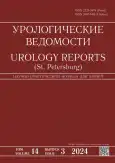Drinking water is the urolithiasis development factor among the rural population of a single region
- Authors: Streltsova O.S.1, Pochtin D.P.2, Lazukin V.F.1, Kuleshova M.A3
-
Affiliations:
- Privolzhskiy Research Medical University
- N.A. Semashko Nizhny Novgorod Regional Clinical Hospital
- BWT BARRIER RUS JSC
- Issue: Vol 14, No 3 (2024)
- Pages: 303-313
- Section: Original articles
- URL: https://bakhtiniada.ru/uroved/article/view/277114
- DOI: https://doi.org/10.17816/uroved628949
- ID: 277114
Cite item
Abstract
BACKGROUND: The urolithiasis incidence in the Nizhny Novgorod Region exceeds the national average that determines the importance of analyzing the causes of its development and creating preventive measures.
AIM: To evaluate the relationship between the urolithiasis incidence and drinking water composition consumed by the rural population of the Nizhny Novgorod Region.
MATERIALS AND METHODS: A chemical analysis of drinking water was performed in 50 rural districts of the Nizhny Novgorod Region (a total of 61 samples). Water was taken from centralized water supply sources, artesian wells and boreholes, and springs. The relationship between the urolithiasis incidence and chemical composition measures of drinking water was assessed.
RESULTS: Differences in the impurity content of drinking water were found between districts with different values of urolithiasis incidence. Exceeding the standard values for impurities specified in the Sanitary regulations and standards (SanPin) was most commonly detected in water from districts with the highest incidence of urolithiasis. An increase in the calcium/magnesium ratio was the most commonly noted in drinking water from these districts. In 41 (67.2%) of 61 samples, an increase of calcium level was detected. The hardness of drinking water was higher than the standard in 33.3–38.8% of samples depending on the water intake source.
CONCLUSIONS: Drinking water with a high level of hardness and mineralization is one of the etiological factors for the development of urolithiasis in Nizhny Novgorod Region. In rural areas of this region with a high incidence of urolithiasis, the monitoring of the state of central water supply sources and the impurity content in drinking water should be intensified.
Keywords
Full Text
##article.viewOnOriginalSite##About the authors
Olga S. Streltsova
Privolzhskiy Research Medical University
Author for correspondence.
Email: strelzova_uro@mail.ru
ORCID iD: 0000-0002-9097-0267
SPIN-code: 9674-0382
Dr. Sci. (Medicine), Professor
Russian Federation, Nizhny NovgorodDmitry P. Pochtin
N.A. Semashko Nizhny Novgorod Regional Clinical Hospital
Email: dpochtin@mail.ru
ORCID iD: 0000-0003-4634-408X
Russian Federation, Nizhny Novgorod
Valery F. Lazukin
Privolzhskiy Research Medical University
Email: valery-laz@yandex.ru
ORCID iD: 0000-0003-0916-0468
SPIN-code: 3400-9905
Cand. Sci. (Biology)
Russian Federation, Nizhny NovgorodMaria A Kuleshova
BWT BARRIER RUS JSC
Email: Kuleshova.ma@yandex.ru
Russian Federation, Moscow
References
- Skolarikos A, Jung H, Neisius A, et al. EAU guidelines on urolithiasis. European Association of Urology; 2017. 117 p. Available from: https://uroweb.org/guidelines/urolithiasis
- Apolikhin OI, Sivkov AV, Komarova VA, et al. Incidence of urolithiasis in the Russian Federation (2005–2016). Experimental and clinical urology. 2018;(4):4–14. EDN: VRTKIC
- Aleksandrova GA, Polikarpov AV, Golubev NA, et al. Morbidity of the total population of Russia in 2016. Statistical materials. Part I. Moscow; 2017. 140 p. (In Russ.)
- Kaprin AD, Apolikhin OI, Sivkov AV, et al. The incidence of urolithiasis in the Russian Federation from 2005 to 2020. Experimental and Clinical Urology. 2022;15(2)10–17. EDN: EATILC doi: 10.29188/2222-8543-2022-15-2-10-17
- Rosstat. Health care in Russia. 2023. Statistical compendium. Moscow; 2023. 179 p. (In Russ.)
- Endovitsky AA, Liutsko VV. Dynamics of the incidence of diseases of the genitourinary system in the Russian Federation in 2015–2021. Current problems of health care and medical statistics. 2022;(4):256–268. EDN: GGMSDP doi: 10.24412/2312-2935-2022-4-256-268
- Panhwar AH, Kazi TG, Afridi HI, et al. Evaluation of calcium and magnesium in scalp hair samples of population consuming different drinking water: risk of kidney stone. Biol Trace Elem Res. 2013;156(1–3):67–73. doi: 10.1007/s12011-013-9850-1
- Streltsova OS, Krupin VN, Lazukin VF, et al. Prevalence and predictors of incidence of urolithiasis in a representative region. Urology reports (St. Petersburg). 2022;12(2):105–116. EDN: HECSRO doi: 10.17816/uroved105423
- eisspb.ru [Internet]. Sanitary rules and norms SanPiN1.2.3685–21 [cited 2024 March 2]. Available from: https://www.eisspb.ru/files/SanPiN2.1.3685-21Hygienicstandards.pdf (In Russ.)
- rospotrebnadzor.ru [Internet]. State report. On the state of sanitary and epidemiological well-being of the population in the Russian Federation in 2019 [cited 2024 March 2]. Available from: https://www.rospotrebnadzor.ru/documents/details.php? ELEMENT_ID=14933&ysclid=m1mkzyhl7c644525096 (In Russ.)
- Petrov EYu, Kucherenko NS, Lipshits DA, Marakhova LB. In Nizhny Novgorod region 54 water pollution hotspots are considered dangerous. Industrial and environmental safety, labor protection. 2015;(9). [cited 2024 March 2] Available from: https://prominf.ru/article/v-nizhegorodskoy-oblasti-54-ochaga-zagryazneniya-vody-schitayutsya-opasnymi (In Russ.)
- Antonov VG, Zheregelya SN, Karpishchenko AI, Minaeva LV. Water-electrolyte metabolism and its disorders: a guide for physicians. Karpischenko AI, editor. Moscow: GEOTAR-Media; 2022. 208 p. (In Russ.)
- Guo Z-L, Wang J-Y, Gong L-L, et al. Association between cadmium exposure and urolithiasis risk: A systematic review and meta-analysis. Medicine (Baltimore). 2018;97(1):e9460. doi: 10.1097/MD.0000000000009460
- Medvedev EV. Relationship between microelements content of drinkable water and nephro-lithiasis formation in Moscow Region residents. Russian journal of occupational health and industrial ecology. 2007;(2):14–17. EDN: KGLFED
- Sulaiman SK, Enakshee J, Traxer O, Somani BK. Which type of water is recommended for patients with stone disease (Hard or soft water, tap or bottled water): Evidence from a systematic review over the last 3 decades. Curr Urol Rep. 2020;21(1):6. doi: 10.1007/s11934-020-0968-3
- Mazaev VT, Shlepnin TG, Shafirov YB, et al. Sanitary rules and norms SanPiN2.1.4.1074–01. Moscow; 2002 [cited 2024 March 2] Available from: https://files.stroyinf.ru/Data1/9/9742 (In Russ.)
- nizhstat.gks [Internet]. Territorial body of the Federal State Statistics Service for Nizhny Novgorod Region [cited 2024 March 2]. Available from: https://nizhstat.gks.ru (In Russ.)
- nbcrs.org [Internet]. Water resources, availability of rivers and lakes in Nizhny Novgorod region [cited 2024 March 2]. Available from: https://www.nbcrs.org/regions/nizhegorodskaya-oblast/vodnye-resursy-nalichie-rek-ozer (In Russ.)
- svyato.info [Internet]. Water resources of Nizhny Novgorod region [cited 2024 March 2]. Available from: https://svyato.info/nizhegorodskaja-oblast/1930-podzemnye-vody.html (In Russ.)
- Skugoreva SG, Ashihmina TYa, Fokina AI, Lyalina EI. Chemical grounds of toxic effect of heavy metals (review). Theoretical and applied ecology. 2016;(1):4–13. EDN: VXCBRP
- vvugms.meteorf.ru [Internet]. History of the Hydrometeorological Service on the Upper Volga River [cited 2024 March 2]. Available from: https://vvugms.meteorf.ru/o-sluzhbe/istoriya-fgbu-verxne-volzhskoe-ugms/istoriya-gidrometsluzhbyi-na-verxnej-volge (In Russ.)
Supplementary files









